
Dan used oversized strap pins on both the guitar and bass models that is rumored to have been manufactured near the
Ampeg factory in Linden, NJ. The extra flare to the pins were helpful in the day & age before locking type strap pins
were available. As seen upper left, on the upper cutaway horn, notice how the strap pin is cushioned from the acrylic
body using felt type spacers. At the upper right, Dan employed two strap pins on the bottom for several reasons.
"First off, I like the ability to choose whether I want the instrument up higher, or slung down low and you can
accomplish this on my guitars without always having to adjust the guitar strap all the time. Secondly, by not putting
the strap pin at the very center point of the body the instrument tends to stay snug up against you, whereas other
guitars tend to roll away from you as you are playing. The next reason is that I also like the way it looks, as it
accentuates, or accents the cutaway horns - giving the instrument a balanced look. Lastly, it makes it very easy to
lean the guitar up against an amp without the fear of it tipping over so easily. Guitar stands were available but most
musicians simply leaned their instruments against things back then. Maybe they still do, I don't know - but I wanted
to minimize the chances of it happening. So that's the story behind the dual strap pins."
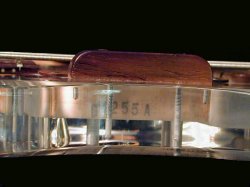
|
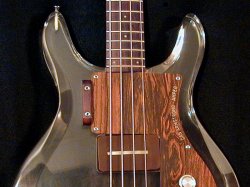
|
As seen upper left, the bass guitar, like most other basses utilize a thumbrest so the bass player can rest the thumb
against it while using the fingers to strike the strings. The thumbrest on the Dan Armstrong basses was made of
rosewood, and secured to the acrylic top with two phillips screws. As can be seen upper right, it was placed on top of,
and adjacent to, the scratchplate. Some players do not like a thumbrest in their way, and as a result they often remove
it and usually put it in their case, where unfortunately, many of them tend to get lost over time.
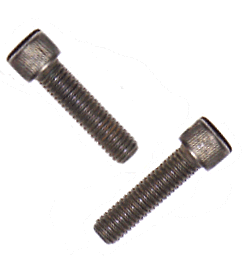
|
Matt Umanov designed the prototype guitar and bass necks to attach to the body using four black cap screws. Matt
goes on to say "The prototypes had matte-black Allen-head cap screws, I think with a 5/16-20 thread, or maybe
3/8-20; the outer surface of the heads had tiny grooves along the axis, almost like mini-splines. I had to buy a whole
box of them (maybe 100 or so) at the time, even though I only needed eight, four for each instrument. I no longer have
the remainder of the box, which is unusual for me."
Just as this site went live Matt e-mailed me stating that he had "found a few of the black cap screws from the
original batch that I used to attach the necks on the prototype guitar and bass, along with an Allen wrench that is
probably the one mentioned on that shopping list I sent you a photo of." [the list can be seen in the guitar section]. As can
be seen at left, a couple of left over black cap screws that Matt spoke of. It's haunting to reflect upon the fact
that these two came from the same box that Matt used to built the prototypes - as by a twist of fate, when building
them he could just as easily have grabbed these two instead.
|
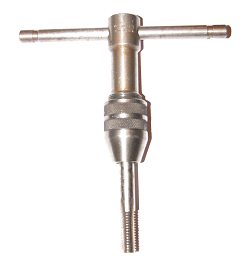
|
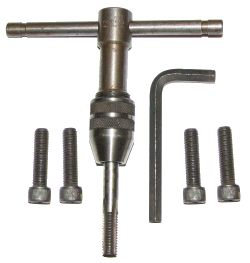
|
At upper left a large tap wrench and tap, which Matt keeps in his "drawer of machinist's hand tools, is also the
very one that I bought for that same shopping list" [seen in the guitar section] - as for the tap, Matt goes on
to add "it's got the end ground flat, obviously by hand, so that I could thread flat-bottomed blind holes in the
end of the neck all the way down to the bottom of the holes." Matt continues, clarifying the size of the tap,
stating "3/8-16 NC thread by the way, probably because that was the size that looked most appropriate to me
amongst what they had at the hardware store that day. Pretty good store though; most places wouldn't have nice machine
parts like that today. I remember the store, it was called Lilien Hardware which was owned and run
by Herb Lilien.
The store was right on our corner, just a few doors down. They closed at least 20 years ago and sold the building.
There's been a restaurant there for years; it's a very trendy block now."
At upper right, all of the tools and screws together. According to Matt "All of these items are of course
American-made. The tap wrench is a General No. 166 (I've recently become friends with the owner of that company, and
he tells me that most of their tools are made in China today). The tap is marked Besly 3/8 16 NC GH3 M2 F3 CAST IRON;
you can sort of tell from the photo that its end has been ground square by hand. The cap screws say FMX on top and are
quite nicely formed. The Allen wrench has no markings."
It's important to reflect upon the fact that these are not just any ole shop tools, they are thee very
tools that Matt used to tap and run cap screws to secure the maple necks to the acrylic bodies on the prototypes.
Matt continues, adding "The back of the body was counter bored so the tops of the screw heads would be flush with
the back of the guitar, and the corresponding holes in the underside of the neck were tapped for the screws to go into.
So: from the rear of the guitar, you see the surface of those nice matte-black bolt heads with the six-sided holes in
them; and from the side of the guitar, you see two drillings, each with a larger diameter at the rear (for the screw head),
and faintly through it (due to the inner surface having been cut by the drill bit looking somewhat fuzzy) these nice
faint threads of the black bolt."
Lastly he states "In retrospect, threading steel bolts into maple was not the best idea in the world in a few
areas of complete thought, but it sure looked elegant from the back of the guitar and through the body from the edge
too, and I was very proud of that. Thanks to Matt, we can now view the very tap and tap wrench that he used."
continue
menu
Names and images are TMand © Dan Armstrong / Ampeg. All rights reserved.
All other names and images are TMand © of their respective owners. All rights reserved.
|
| |

